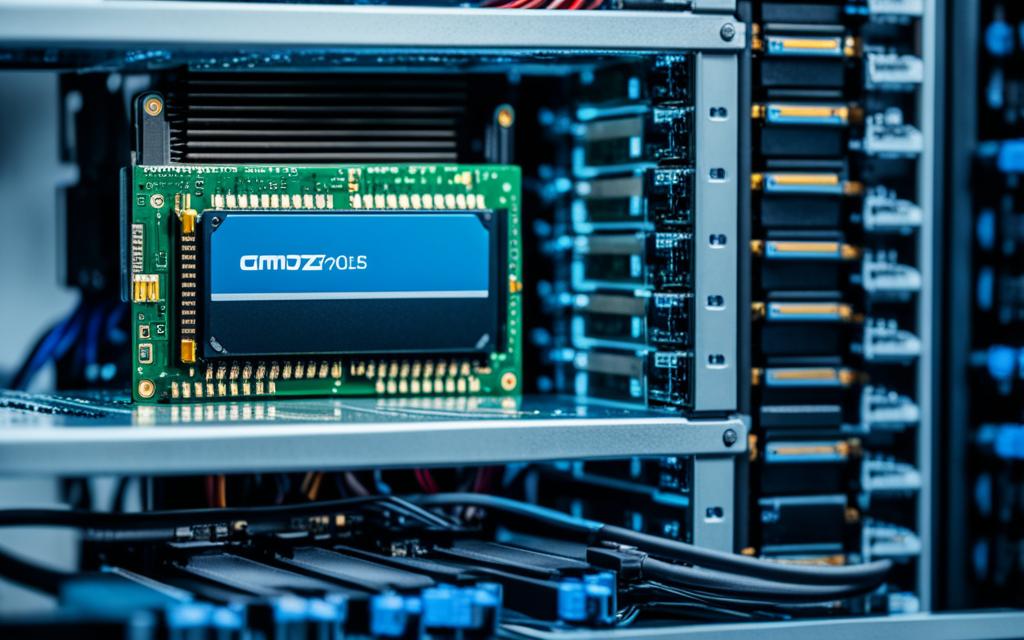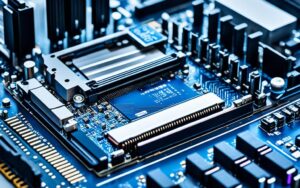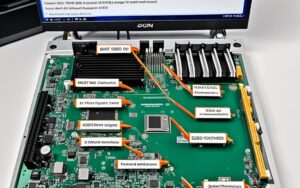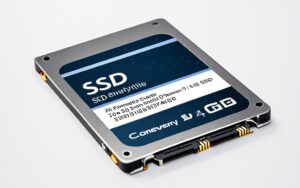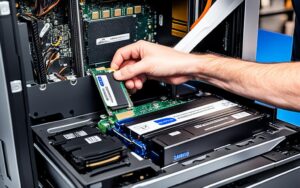Table of Contents
Switching your storage to an M.2 SSD boosts your computer’s speed and performance. This is great for those wanting their devices to run faster and more smoothly. M.2 SSDs are smaller but faster than old SATA SSDs, with speeds up to 3200MB/s using NVMe technology. That’s much quicker than SATA SSDs’ 600MB/s1. This article helps you clone your disk, so you keep everything while upgrading. Using tools like EaseUS Disk Copy makes cloning easy. It lets you move to a better storage without losing data2. For anyone looking to move files quicker or need more space, learning how to install an M.2 SSD is key to getting it right.
Key Takeaways
- M.2 SSDs offer higher capacities and faster speeds, making them suitable for demanding applications.
- Using reliable cloning software like EaseUS Disk Copy streamlines the cloning process.
- Prepare your system and tools for a smooth SSD upgrade experience.
- Ensure the new M.2 SSD is compatible and ideally 1TB or more for optimal performance.
- Follow the outlined steps meticulously to avoid issues post-cloning.
Understanding SSD and M.2 Technology
Solid State Drives (SSDs) have revolutionised how we store data. They offer faster speeds and are more reliable. SSDs use flash memory, which means data is accessed much quicker than traditional drives. This technology has greatly benefited both everyday users and businesses.
What is an SSD?
SSDs are storage devices but without the moving parts found in old hard drives. They use memory chips to reduce access time and last longer. Leading brands like Sabrent, PNY, and Western Digital offer SSDs with helpful tools. They come with cloning software like Acronis True Image for easy data migration3. Samsung has its bespoke tool, the Samsung Data Migration software, which simplifies upgrading3.
The Benefits of M.2 SSDs
M.2 SSDs elevate the strengths of traditional SSDs. They’re tinier, saving precious space inside computers4. These SSDs vary in size, from 22×30 mm to 22×110 mm. The larger sizes can store up to 2 terabytes4. M.2 SSDs are faster, especially models equipped with NVMe technology. They can achieve impressive read and write speeds, essential for intensive computing tasks, and outperform standard SATA SSDs4.
Preparing for Cloning
Getting ready is key for a smooth SSD cloning process. You need the correct tools and to know if your computer is compatible. This is crucial to meet the hardware needs.
Necessary Tools and Software
For a successful SSD to M.2 SSD clone, you’ll need several things:
- A new M.2 SSD
- Disk cloning software like EaseUS Disk Copy, which makes the cloning easy and allows copying each sector
- A screwdriver for the physical installation
Using tools like EaseUS Disk Copy helps to transfer data efficiently. It ensures the disk sizes match well for a smooth process. The cloning time can differ based on data size and the method used. This highlights the need to choose the right cloning tools1.
Compatibility Checks for Your Computer
Before starting to clone, check if the M.2 SSD fits your computer. Make sure your motherboard has M.2 connections and the new SSD is the correct size and type. Look into how many SSD slots you have and know the M.2 standards your motherboard uses.
It’s important to set things up right to avoid problems. Sometimes, after moving data, your computer might not start right. This means the cloning software, like AOMEI Backupper Professional, is very important for a successful clone5. After cloning, you must check the BIOS settings to ensure the computer starts with the new SSD1.
How to Clone SSD to M.2
To clone your SSD to a new M.2 drive correctly, you need to follow certain steps. These steps will help you with installing M.2 SSD, booting from original SSD, and choosing the right software. Doing so ensures a smooth switch.
Step 1: Install Your New M.2 SSD
Start by fitting the new M.2 SSD into your PC. Make sure it’s properly placed and screwed in the slot. The right installation is key for good performance and stability.
Step 2: Boot from the Original SSD
Once the M.2 SSD is in, turn on your PC. Check you are booting from the original SSD. Go to the BIOS settings to make sure the original SSD works fine before going ahead.
Step 3: Download Disk Cloning Software
Now, you need to download cloning software that suits your system. EaseUS Disk Copy is a good choice. It’s trusted and efficient for cloning. This software supports different versions of Windows, including Windows 11/10/8.1/8/71.
Step 4: Start the Cloning Process
Install the software and begin cloning by following a cloning process tutorial. Pick your original SSD as the source. Make sure the M.2 SSD is set as the destination. The cloning usually takes about 3-5 minutes2. Double-check disk choices and arrange partitions smartly to use your new SSD well. This ensures it runs smooth later on.
Post-Cloning Steps
After you’ve cloned your SSD to a new M.2 drive, make sure to boot from it. Go into the BIOS or UEFI settings to change the boot order. This makes your computer start from the new SSD. This step improves speed because M.2 drives can move data much faster. They are quicker than old SSDs, with speeds up to 4000 MB/s6.
Setting the New M.2 SSD as Boot Drive
It’s usually easy to choose a new boot drive. Just restart your computer and press a key like F2 or Delete to open BIOS/UEFI. Then, find the boot menu and pick your M.2 SSD as the main boot device. Save and exit. Your computer will then start up from the new drive, making everything run faster.
Managing Your Old SSD
What to do with your old SSD depends on its state and your needs. If it’s still good, you can use it for extra storage. Keep less important files on it, so your new M.2 SSD runs more efficiently. If you don’t need the old SSD, make sure to erase it to keep your data safe. Managing your drives well keeps your computer running smoothly.
For more tips on SSD management and cloning, check out these links: A detailed guide on cloning M.2 SSD and a step-by-step installation guide for SSDs.
Over 60 million people trust AOMEI Backupper Professional for cloning. It works with many disk types and sizes5. Looking after your old SSD is key to keeping your computer speedy.
Troubleshooting Common Issues
Upgrading your system with an SSD to an M.2 can boost performance. But, running into problems is common. A familiar issue is the new SSD not showing up in the BIOS. It’s important to first check that everything is connected properly. You should also see if the BIOS settings are right for the new hardware. Wrong settings can stop the BIOS from seeing the SSD, which affects how it works in your system.
SSD Not Detected in BIOS
If the SSD doesn’t show up in BIOS, resetting the BIOS to the default might help. Then, make sure your motherboard’s firmware is up to date. Updates can fix compatibility problems with new drives. It’s also a good idea to turn off Secure Boot for a while7. This has helped many users. Re-plugging the SSD and restarting could make it show up.
Boot Issues After Cloning
After cloning, you might not be able to boot from the new SSD if BIOS isn’t set up correctly. If Windows won’t start, it could be due to wrong partitioning or compatibility issues. Use a bootable Windows USB to fix bootloader problems7. This often gets your system working again. With careful planning, switching to your new SSD can go very smoothly8.
For more help and advice, look at this detailed cloning guide. It has useful tips for avoiding common issues during installation8.
FAQ
What benefits will I experience after upgrading to an M.2 SSD?
Switching to an M.2 SSD boosts your system’s performance. You’ll see quicker data transfer speeds and less waiting time. It’s great for gamers or anyone using intense software.
How do I choose the right M.2 SSD for my computer?
First, check your computer’s motherboard for M.2 slot compatibility. Look at the SSD’s length and whether it uses SATA or NVMe. This helps pick the perfect M.2 SSD for you.
Do I need special software for the cloning process?
Yes, you need good cloning software like EaseUS Disk Copy. It’s crucial for a smooth data transfer to your new M.2 SSD.
What should I do if my new M.2 SSD is not detected in BIOS?
Check the connections if the BIOS doesn’t show your M.2 SSD. Make sure it’s properly installed. Also, adjust your BIOS settings to recognize the SSD.
Can I continue using my old SSD after cloning?
Definitely! Your old SSD can become extra storage or you can wipe it clean. It’s a smart way to use all your storage options.
How do I set the M.2 SSD as the boot drive?
Change your boot drive in the BIOS or UEFI settings. Put the M.2 SSD first in line. This way, your system boots from the new SSD.
Is the cloning process complicated?
Though it seems tough, cloning is easy with the right guide. EaseUS Disk Copy helps make the process simple, even for beginners.
What if I experience boot issues after cloning?
If booting fails after cloning, check your BIOS’s boot sequence. Ensure your cloned SSD is set up right. Installing the correct drivers can also help.
Are there risks involved in cloning my SSD?
Cloning comes with a slight chance of data loss. But, using trusted software like EaseUS Disk Copy and backing up data can prevent this risk.
Source Links
- https://www.easeus.com/disk-copy/clone-resource/how-to-clone-hdd-to-m2-ssd.html – How to Clone Windows OS from HDD/SSD to M.2 SSD
- https://www.easeus.com/backup-utility/clone-m2-ssd-to-larger-m2-ssd.html – How Do I Clone M.2 SSD to Larger M.2 SSD on Laptop/PC
- https://www.sabrepc.com/blog/Computer-Hardware/cloning-storage-drives-upgrade-your-ssd-without-losing-data – How to Clone Storage Drives & Upgrade Your SSD
- https://www.techtarget.com/searchstorage/definition/M2-SSD – What is an M.2 SSD?
- https://www.ubackup.com/clone/clone-hdd-to-m2-ssd-4348.html – How to Clone HDD to M.2 SSD Step by Step (Bootable)
- https://www.isumsoft.com/windows-10/clone-sata-ssd-to-nvme-m2-ssd.html – How to Clone SATA SSD to M.2 NVMe SSD in Windows 10
- https://community.spiceworks.com/t/clone-m-2-to-m-2-nvme/802332 – Clone m.2 to m.2 nvme
- https://forums.tomshardware.com/threads/trouble-cloning-a-failing-m-2-sdd-to-a-new-hdd-because-of-smart-error.3804526/ – Question – Trouble cloning a failing M.2 SDD to a new HDD because of SMART error ?


